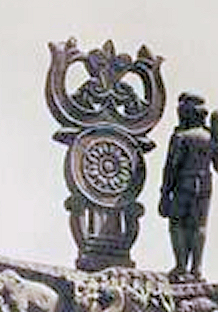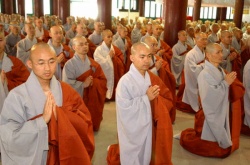Three Jewels
The Three Jewels (Skt. triratna; Tib. könchok sum; Wyl. dkon mchog gsum) are Buddha, Dharma and Sangha, the objects of refuge. The Tibetan könchok sum literally means the three 'rare and supreme' ones.
Alternative Translations
Source
The Three Jewels, also called the Three Treasures, Three refuges, Precious Triad, or most commonly the Triple Gem (त्रिरत्न (Triratna)) (Pali: Tiratana), are the three things that Buddhists take Refuge in, and look toward for guidance, in the process known as taking refuge.
The Three Jewels are:
- Sanskrit, Pali: The Enlightened or Awakened One; Chn: 佛陀, Fótuó, Jpn: 仏, Butsu, Tib: sangs-rgyas, Mong: burqan
- Depending on one's interpretation, it can mean the historical Buddha (Shakyamuni) or the Buddha nature—the ideal or highest spiritual potential that exists within all beings;
- Sanskrit: The Teaching; Pali: Dharmam, Chn: 法, Fǎ, Jpn: Hō, Tib: chos, Mong: nom
- The teachings of The Buddha.
- Sanskrit, Pali: The Community; Chn: 僧, Sēng, Jpn: Sō, Tib: dge-'dun, Mong: quvara'
- The community of those who have attained Enlightenment, who may help a practicing Buddhist to do the same. Also used more broadly to refer to the community of practicing Buddhists, or the community of Buddhist monks and nuns.
Refuge formula
Taking refuge in the Three Jewels is central to Buddhist lay and monastic ordination ceremonies, as originated by Gautama, (The Buddha), according to the scriptures. The practice of taking Refuge on behalf of young or even unborn children is mentioned in the Majjhima Nikaya, recognized by most scholars as an early text.
Taking Refuge in The Three Jewels is generally considered to make one officially a Buddhist. Thus, in many Theravada Buddhist communities, the following Pali chant, the Vandana Ti-sarana is often recited by both monks and lay people:
|
The Burmese Pali version, which differs from traditional Pali pronunciation (to suit the Burmese language phonology), is as follows (in the Burmese script and IPA):
|
1ဒုတိယမ္ပိ dṵtḭjàɴpḭ and တတိယမ္ပိ (ta̰tḭjàɴpḭ) are prefixed to the chant when lay members seek the Refuge for the second and third times respectively.
The Cambodian version, or បទសរភញ្ញ (EN: Bot Sa-Rak-Phorgn), was written by Samdech Sangha Raja Jhotañano Chuon Nath with greater descriptions of the Three Jewels with Cambodian touch at the ending.
|
The Mahayana Chinese/Korean/Japanese version differs only slightly from the Theravada:
|
The prayer for taking Refuge in Tibetan Buddhism.
|
Importance
The Triple Gem is in the center of one of the major practices of mental "reflection" in Buddhism; the reflection on the true qualities of the Buddha, Dharma and Sangha. These qualities are called the Mirror of the Dharma in the Mahaparinibbana Sutta and help the practitioner attain the true "mind like a mirror".
In the commentary on the Apannaka Jataka Buddha declares:
- Disciples, nowhere between the lowest of hells below and the highest heaven above, nowhere in all the infinite worlds that stretch right and left, is there the equal, much less the superior, of a Buddha. Incalculable is the excellence which springs from obeying the Precepts and from other virtuous conduct.
- By Taking Refuge in the Triple Gem, one escapes from Rebirth in states of Suffering. In forsaking such a Refuge as this, you have certainly erred. In the past, too, men who foolishly mistook what was no Refuge for a real Refuge, met disaster.
Explication
The qualities of The Buddha, Dharma, and Sangha are frequently repeated in the ancient texts and are called "Mirror of the Dhamma" or "Dhamma Adassa".
- The Buddha
- "The Blessed One is an Arahant, perfectly enlightened, accomplished in true knowledge and conduct, fortunate, knower of the world, unsurpassed leader of persons to be tamed, teacher of devas and humans, the Enlightened One, the Blessed One."
In some traditions The Buddha as Refuge is taken to refer to the historical Buddha and also 'the full development of mind', in other words, the full development of one's highest potential, i.e. recognition of mind and the completion or full development of one's inherent qualities and activities.
- the Dharma
- "The Dhamma is well expounded by the Blessed One, directly visible, immediate (eternal or not subject to time), inviting one to come and see, applicable, to be personally experienced by the wise."
Refuge in the Dharma, in the Vajrayana, tradition includes reference not only to the words of The Buddha, but to the living experience of realization and teachings of fully realized practitioners. In Tibetan Buddhism, it includes both the Kangyur (the teaching of The Buddha) and the Tengyur (the commentaries by realized practitioners) and in an intangible way also includes the living transmission of those masters, which can also be very inspiring.
- "The Sangha of the Blessed One's disciples is practicing the good way, practicing the straight way, practicing the true way, practicing the proper way; that is, the four pairs of persons, the eight types of individuals - This Sangha of the Blessed One's disciples is worthy of gifts, worthy of hospitality, worthy of offerings, worthy of reverential salutation, the unsurpassed field of merit for the world."
In the Vajrayana, a more liberal definition of Sangha can include all practitioners who are actively using The Buddha's teachings to benefit themselves and/or others. It can be more strictly defined as the 'Realized Sangha' or 'Arya-Sangha',
in other words, practitioners and historical students of The Buddha who have fully realized the nature of their mind, also known as realized Boddhisatvas; and 'Ordinary Sangha', which can loosely mean practitioners and students of The Buddha who are using the same methods and working towards the same goal.
Tibetan Buddhism
In Tibetan Buddhism there are three Refuge formulations,
the Outer, Inner and Secret forms of the Three Jewels.
The 'Outer form is the 'Triple Gem', (Sanskrit:Triratna),
the 'Inner form' is the Three Roots and
the 'Secret form is the 'Three Bodies' or Trikaya of a Buddha.
These alternative Refuge formulations are employed by those undertaking Deity Yoga and other tantric practices within the Tibetan Buddhist Vajrayana tradition as a means of recognizing Buddha-nature.
|
<font=5>Tibetan Buddhist Refuge Formulations | |||
|
Outer or 'Three Jewels' |
| ||
|
Inner or 'Three Roots' | |||
|
| |||
|
| |||
|
blue hum |
white om | ||
History

The three gems are called this because of their treasured value to Buddhists, as well as their indestructible and unchanging nature.
The Three Gems when used in the process of taking refuge, become the Three refuges. In this form, the metaphors occur very frequently in the ancient Buddhist Texts, and here The Sangha is used more broadly to refer to either The Sangha of Bhikkhus, or The Sangha of Bhikkhunis.
Diamond Mind
Buddha's mind in his earth body or nirmanakaya is frequently associated with the greatest gem of all, the diamond, the hardest natural substance. In the Anguttara Nikaya(3:25), Buddha talks about the diamond mind which can cut through all delusion.
Ratana-Sutta
The expression Three Gems are found in the earliest Buddhist literature of the Pali Canon, besides other works there is one sutta in the Sutta-nipata, called the Ratana-Sutta which contains a series of verses on the Jewels in the Buddha, Dharma, and Sangha.
In the Ratana-Sutta, all the qualities of The Sangha mentioned are attributes of The Buddha's enlightened disciples:
- One who is irascible and very irritable, displaying anger, hatred and sulkiness; such a one is said to be a person with a mind like an open sore.
- One who understands the Four Noble Truths correctly is said to have a mind like a flash of lightning.
- One who has destroyed the mind-intoxicating defilements and realized the liberation of mind and the liberation by knowledge is said to have a mind like a diamond
Jainism and Taoism
Jainism and Taoism also use "three jewels" metaphorically. When Buddhism was introduced into China, ratnatraya was translated as Three Treasures sanbao (Chinese: 三寶; pinyin: sānbǎo; Wade–Giles: san-pao; literally "three jewels/treasures"), a term that first occurred in the Tao Te Ching.
In his analysis of the Tao Te Ching, Victor H. Mair notes that the jewel metaphor was already widely used in Indian religious metaphor before the Tao Te Ching was written. In Jainism too,
For the Jains, the Three Jewels are a metaphor for describing conduct and knowledge:
- samyag-darśana (correct perception or insight)
- samyag-jñāna (correct knowledge)
- samyag-cāritra (correct conduct).
Art

The Three Jewels are also symbolized by the Triratna, composed of (from bottom to top):
- A lotus flower within a circle.
- A diamond rod, or vajra.
- An ananda-chakra.
- A trident, or trisula, with three branches, representing the threefold jewels of Buddhism: Buddha, the Dharma and The Sangha.
On representations of the footprint of the Buddha, the Triratna is usually also surmounted by the Dharma wheel.
The Triratna can be found on frieze sculptures at Sanchi as the symbol crowning a flag standard (2nd century BCE), as a symbol of The Buddha installed on The Buddha's throne (2nd century BCE), as the crowning decorative symbol on the later gates at the Stupa in Sanchi (2nd century CE), or, very often on The Buddha footprint (starting from the 1st century CE).
The Triratna can be further reinforced by being surmounted with three Dharma wheels (one for each of the three jewels of Buddhism: the Buddha, the Dharma and The Sangha).
The Triratna symbol is also called nandipada, or "bull's hoof", by Hindus.
Coins
There are a number of examples of the Triratna symbol appearing on historical coins of Buddhist kingdoms in the Indian sub-continent. For example, the Triratna appears on the 1st century BCE coins of the Kingdom of Kuninda in the northern |Punjab. It also surmounts the depictions of stupas, on some the coins of the Indo-Parthian king Abdagases of the 1st century, CE and on the coins of some of the Kushan kings such as Vima Kadphises, also of the 1st century CE.
Source
(Sanskrit: Rathatraya, Also: Three Precious Ones, Three Jewels Gems, Three Jewels Refuges)
- 1. The Buddha
- 2. The dharma (truth or teachings)
- 3. The sangha (monastic community)
The three essential components of Buddhism. They are the objects of veneration. Buddhists take refuge in them by pronouncing the threefold refuge formula, thus acknowledging themselves to be Buddhists. Sometimes referred to as the Teacher, the Teaching and the Taught.



